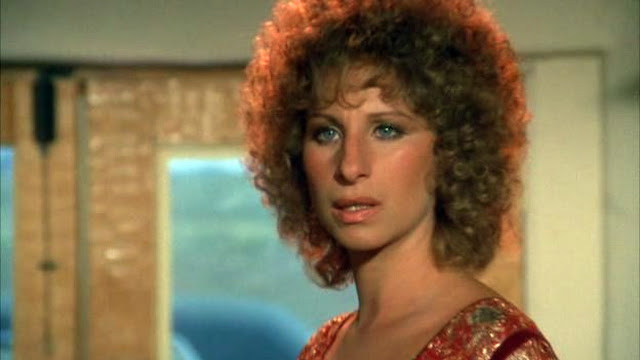 |
| Frame grab from A Star Is Born ( Frank Pierson, 1976) |
Each version of A Star Is Born may detail the rise of an unknown, but does so through extremely well-known performers, albeit ones at different stages of their careers. [...] Barbra Streisand [...] was at the height of her career in 1976. Her domination of A Star Is Born (she contributed to the writing and even, as Kris Kristofferson, her co-star, saw it, the directing [(Burke, Tom. "Kris Kristofferson Sings the Good-Life Blues." Esquire 86 (December 1976): 126–28ff), 208-9]) was another manifestation of a desire to play out aspects of her own life. The credited director has recounted at length how, during preproduction, Streisand debated the degree to which her autobiography should be reflected in Esther Hoffman ([Pierson, Frank. "My Battles with Barbra and Jon." New York 9 (November 15, 1976): 49–60], 50). If James Mason's character in the 1954 film becomes through role reversal the "fictional counterpart of the neurotic, self-destructive person that Garland [had] become" ([Jennings, Wade. "Nova: Garland in 'A Star Is Born.'" Quarterly Review of Film Studies 4, no. 3 (summer 1979): 321–37], 333), then Streisand's Esther Hoffman directly fulfills everything that Streisand herself has become by 1976. Richard Dyer even suggests that among the "number of cases on which the totality of a film can be laid at the door of the star" the case can be made "most persuasively" for Streisand's A Star Is Born (Dyer, Richard. Stars. London: BFI, 1979], 175) [Jerome Delamater, '"Once More, from the Top": Musicals the Second Time Around', in Horton, Andrew, Play it again, Sam: retakes on remakes. Berkeley: University of California Press, 1998, p. 84]Film Studies For Free wishes a very happy 70th birthday to Barbra Streisand, actor, singer, songwriter, film director, producer, and queer feminist icon extraordinaire.
Below, you can find a tiny little celebration in related scholarly links - the only gift that (rather besotted Barbra fan) FSFF knows how to give.
If anyone knows of any other good items (and it is far too short and unworthy a list so far...), please leave a comment and FSFF will add them to the list.
- Zohar Altman Ravid, 'The star as a Creation and the Star as a creator: The Case of Barbra Streisand' in History of Stardom Reconsidered, edited by Kari Kallioniemi, Kimi Kärki, Janne Mäkelä and Hannu Salmi. Turku: International Institute for Popular Culture, 2007
- Henry Bial, 'How Jews Became Sexy, 1968–1983', Acting Jewish: Negotiating Ethnicity on the American Stage and Screen (University of Michigan, 2005)
- Jerome Delamater, '"Once More, from the Top": Musicals the Second Time Around', in Horton, Andrew, Play it again, Sam: retakes on remakes. Berkeley: University of California Press, c 1998 1998
- Brett Farmer, 'Stage Door Jennies: Interview with Stacy Wolf about her New Book, A Problem Like Maria Gender and Sexuality in the American Musical', Genders.org, Issue 38, 2003
- Rachel Garfield, 'Towards a Re-Articulation of Cultural Identity: Problematising the Jewish Subject in Art', originally in Third Text, Vol. 20, Issue 1, January, 2006, 99–108
- Stephen Godfry, 'The Way We Were', Pro Tem, November 29, 1973 (scroll down in PDF to p. 8)
- Evyatar Marienberg, 'Jews Have the Best Sex: The Hollywood Adventures of a Peculiar Medieval Jewish Text on Sexuality', Journal of Religion and Film, 14.2, 2010
- Arthur Laurents, 'Emotional Reality: Interview by Pat McGilligan', in McGilligan, Patrick. Backstory 2: Interviews with Screenwriters of the 1940s and 1950s (Berkeley: University of California Press, 1991)
- Joel Rosenberg, 'Jewish Experience on Film: An American Overview', American Jewish Yearbook, 1996
- Jérôme Segal and Monika Kaczek, 'Molly Picon and the Cinematic Archetype of a Jewish Woman', CinemaScope, 14, Jan-Jul. 2010
- Greg M. Smith, 'Streisand Shops the Museum Store: Consuming Art on Television', Journal of Popular Film and Television, 30.1 (Spring 2002) 63-68
- Jon Stratton, 'Introduction', Jews, Race and Popular Music (Ashgate, 2009)
- Stacy Wolf, 'Barbra’s “Funny Girl” Body', SandF Online, Double Issue: 3.3 & 4.1
- Stacy Ellen Wolf, 'Introduction', A Problem Like Maria:Gender and Sexuality in the American Musical (University of Michigan Press, 2002)
Sequence from Funny Girl (William Wyler, 1968)
Không có nhận xét nào:
Đăng nhận xét